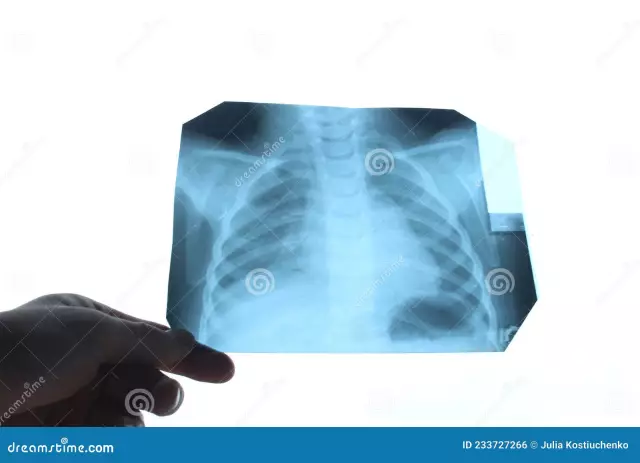- Author Rachel Wainwright [email protected].
- Public 2023-12-15 07:39.
- Last modified 2025-11-02 20:14.
Lungs
Lung structure
The lungs are the organs that provide human breathing. These paired organs are located in the chest cavity, adjacent to the left and right to the heart. The lungs are in the form of half-cones, with the base adjacent to the diaphragm, with the apex protruding 2-3 cm above the clavicle. The right lung has three lobes, the left - two. The skeleton of the lungs consists of treelike branching bronchi. Each lung is covered from the outside by a serous membrane - the pulmonary pleura. The lungs lie in the pleural sac formed by the pulmonary pleura (visceral) and the parietal pleura (parietal) lining the chest cavity from the inside. Each pleura on the outside contains glandular cells that produce fluid into the cavity between the pleural layers (pleural cavity). On the inner (cardial) surface of each lung there is a depression - the gate of the lungs. The pulmonary artery and bronchi enter the gates of the lungs,and two pulmonary veins come out. The pulmonary arteries branch out parallel to the bronchi.

Lung tissue consists of pyramidal lobules, with the base facing the surface. A bronchus enters the apex of each lobule, sequentially dividing with the formation of terminal bronchioles (18-20). Each bronchiole ends with an acinus - a structural and functional element of the lungs. Acini are composed of alveolar bronchioles, which are divided into alveolar passages. Each alveolar passage ends with two alveolar sacs.
Alveoli are hemispherical protrusions consisting of connective tissue fibers. They are lined with a layer of epithelial cells and are abundantly braided with blood capillaries. It is in the alveoli that the main function of the lungs is carried out - the processes of gas exchange between atmospheric air and blood. At the same time, as a result of diffusion, oxygen and carbon dioxide, overcoming the diffusion barrier (epithelium of the alveoli, basement membrane, wall of the blood capillary), penetrate from the erythrocyte to the alveoli and vice versa.
Lung function
The most important function of the lungs is gas exchange - the supply of oxygen to hemoglobin, the removal of carbon dioxide. The intake of oxygen-enriched air and the removal of carbonated air is carried out due to the active movements of the chest and diaphragm, as well as the contractility of the lungs themselves. But there are other lung functions as well. The lungs take an active part in maintaining the required concentration of ions in the body (acid-base balance), are able to remove many substances (aromatic substances, ethers, and others). The lungs also regulate the water balance of the body: about 0.5 liters of water per day evaporate through the lungs. In extreme situations (for example, hyperthermia), this figure can reach up to 10 liters per day.
Ventilation of the lungs is carried out due to the pressure difference. On inspiration, the pulmonary pressure is much lower than atmospheric pressure, due to which air penetrates into the lungs. On exhalation, the pressure in the lungs is higher than atmospheric.
There are two types of breathing: costal (chest) and diaphragmatic (abdominal).
Costal breathing
At the points of attachment of the ribs to the spinal column, there are pairs of muscles that are attached at one end to the vertebra, and the other to the rib. There are external and internal intercostal muscles. The external intercostal muscles provide inspiration. Exhalation is normally passive, and in case of pathology, the internal intercostal muscles help the act of exhalation.
Diaphragmatic breathing
Diaphragmatic breathing is carried out with the participation of the diaphragm. In a relaxed state, the diaphragm is dome-shaped. With the contraction of its muscles, the dome flattens, the volume of the chest cavity increases, the pressure in the lungs decreases compared to atmospheric pressure, and inhalation is carried out. When the diaphragmatic muscles relax due to the pressure difference, the diaphragm returns to its original position.
Regulation of the breathing process
Breathing is regulated by the centers of inhalation and exhalation. The respiratory center is located in the medulla oblongata. Receptors that regulate respiration are located in the walls of blood vessels (chemoreceptors, sensitive to the concentration of carbon dioxide and oxygen) and on the walls of the bronchi (receptors, sensitive to changes in pressure in the bronchi - baroreceptors). There are also receptive fields in the carotid sinus (where the internal and external carotid arteries diverge).
Lungs of a smoking person
In the process of smoking, the lungs are exposed to the strongest impact. Tobacco smoke that penetrates the lungs of a smoking person contains tobacco tar (tar), hydrogen cyanide, nicotine. All these substances are deposited in the lung tissue, as a result, the epithelium of the lungs begins to simply die off. The lungs of a smoking person are a dirty gray or even just black mass of dying cells. Naturally, the functionality of such lungs is significantly reduced. In the lungs of a smoker, ciliary dyskinesia develops, bronchial spasm occurs, as a result of which bronchial secretions accumulate, chronic pneumonia develops, bronchiectasis is formed. All this leads to the development of COPD, a chronic obstructive pulmonary disease.
Pneumonia
One of the most common severe lung diseases is pneumonia. The term "pneumonia" includes a group of diseases with different etiology, pathogenesis, clinic. Classical bacterial pneumonia is characterized by hyperthermia, cough with purulent sputum, in some cases (when the visceral pleura is involved in the process) - pleural pain. With the development of pneumonia, the lumen of the alveoli expands, the accumulation of exudative fluid in them, the penetration of erythrocytes into them, the filling of the alveoli with fibrin, leukocytes. To diagnose bacterial pneumonia, X-ray methods, microbiological examination of sputum, laboratory tests, and blood gas analysis are used. Antibiotic therapy is the mainstay of treatment.
Found a mistake in the text? Select it and press Ctrl + Enter.






